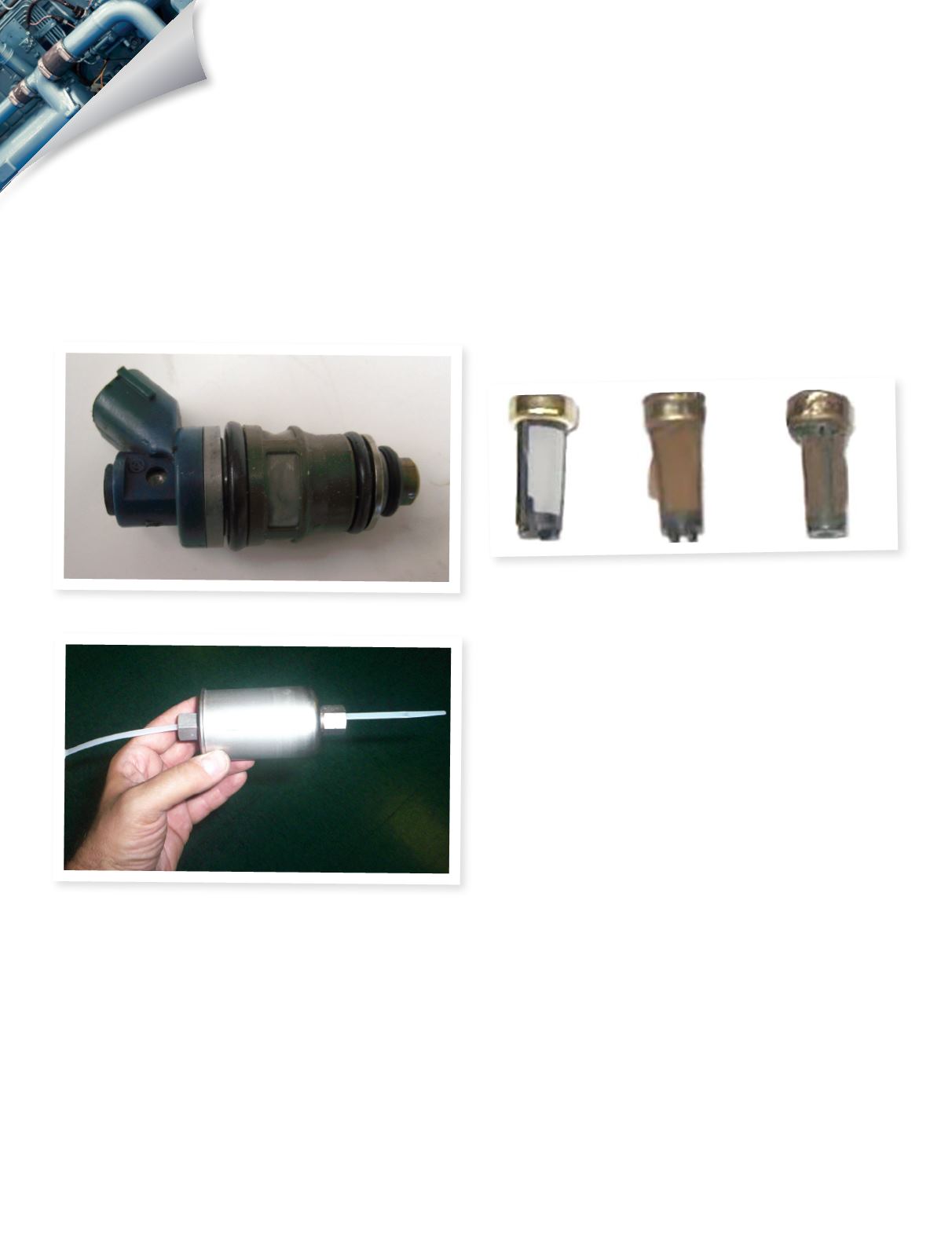
20
MARINE TECHNICIANTODAY | SPRING 2015
Fuel pressure at the injectors is regulated
by a fuel pressure regulator. The regulator is a
diaphragm operated relief valve with fuel pressure on
one side of the diaphragm and opposing spring pressure on the
other side. The regulator’s function is to maintain a constant pressure
differential across the injectors at all times. It is housed inside the TBI
assembly and located in the fuel circuit after the injectors. When the
fuel pressure exceeds spring pressure, a valve will open allowing fuel to
flow back to a reservoir. The balance between spring and fuel pressure
allows the regulator to maintain a constant pressure under all engine
operating conditions.
MPI (Multi Port Injection) currently is the most common type of fuel
injection offered by the marine engine manufactures. The fuel injectors in
this system are also solenoid operated valves controlled by the ECM. MPI
systems have one fuel injector per cylinder, discharging fuel directly into the
intake port just before the intake valve. Since there is no fuel in the intake
manifold, the runners can be tuned for maximum air flow without causing
fuel separation. This precise fuel distribution and increased volumetric
efficiency are the major reasons for the power increase associated with
multi-port fuel injection. Early systems fired the injectors in groups, rather
than one at a time. This is called bank-to-bank injection. Current systems
fire each injector individually for better fuel control, this is called sequential
injection.
The multi-port injector operates much the same as a TBI injector, but its
shape, size, and spray pattern is different due to its location in the intake
manifold. The fuel pressure regulator for the MPI system operates a bit
differently and its location varies. It is still a diaphragm operated relief valve
with fuel pressure on one side of the diaphragm and spring pressure on
the other, but has an additional hose attached from the spring side to a
vacuum port on the intake manifold. Since the regulator’s function is to
maintain a constant pressure differential across all the injectors all the time,
the addition of manifold vacuum is necessary because the injector tips are
located inside the intake manifold. As air flows past the injector tip and
intake manifold vacuum changes, the pressure drop at the tip of the injector
changes and so does fuel volume through the injector. To keep the pressure
drop at the injector tip constant, fuel pressure has to vary. Intake manifold
vacuum acts on the pressure regulator diaphragm changing fuel pressure
in the system. Therefore the pressure drop across the tip now remains
constant, and so does the fuel flow.
Since all of the multi-port injectors are positioned closer to the
combustion chamber than TBI injectors, fuel delivery is more immediate
and precise. Pressurized fuel enters the fuel injector through a basket
filter and the interior of the injector is pressurized. To keep fuel from
running out the other end of the injector, a spring pushes closed a pintle
armature, keeping the tip of the injector closed. Just like TBI injectors
12VDC is supplied to one terminal of the fuel injector and the other
terminal is grounded by the ECM to activate it. The ECM determines
when and how long to activate the injector, thereby injecting a precise
amount of fuel at just the right time. When this occurs, the coil
inside the injector is energized, creating a strong magnetic field. The
magnetic field acts upon the pintle armature and pulls it up off its seat,
overcoming the spring pressure, this exposes the hole at the bottom of
the injector allowing fuel to exit. When the ECM disconnects the ground,
the magnetic field collapses and the spring returns the pintle to the
closed position.
The amount of time the injector is open determines how much fuel is
injected. The open time is measured in milliseconds (1,000ths of a second)
and called pulse width. The ECM constantly measures a wide range of
parameters to determine the amount of fuel to inject. The main parameters
are engine RPM, air temperature, coolant temperature, throttle position,
manifold pressure, and barometric pressure, along with other inputs.
Depending on the fuel injection system, ECM tune, injectors and design,
the fuel injector may fire once every crankshaft revolution or every other
crankshaft revolution. Depending on the system an engine running at 5,000
RPM can fire each fuel injector more than 80 times a second. That’s a lot of
work for such a small part of the system.
The days of OEM’s fitting carburetors on an engine are gone. Fuel injection
systems are now the standard, and are continuing to evolve regarding how
u
Side feed fuel injector
u
Fuel injector top feed internal basket filter. right to left -
new, corrosion, restricted
u
New fuel filter internally defective - offering no filtration


